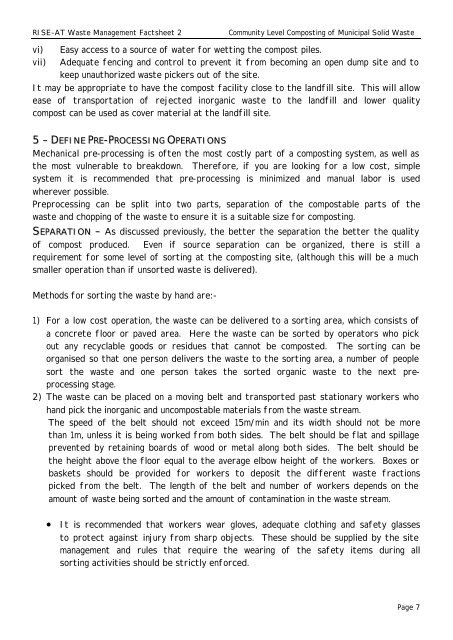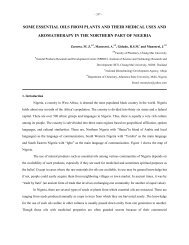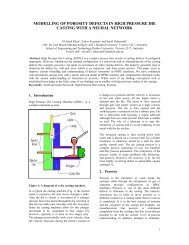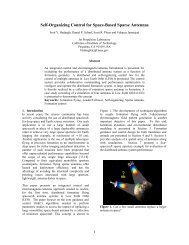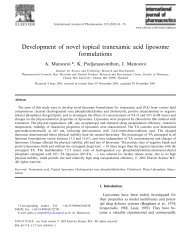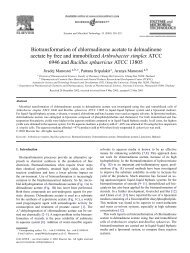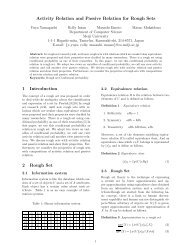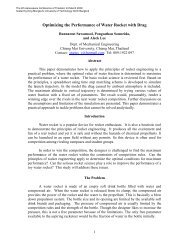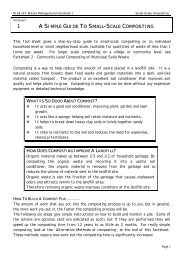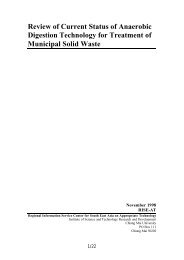COMMUNITY LEVEL COMPOSTING OF MUNICIPAL SOLID WASTE
COMMUNITY LEVEL COMPOSTING OF MUNICIPAL SOLID WASTE
COMMUNITY LEVEL COMPOSTING OF MUNICIPAL SOLID WASTE
Create successful ePaper yourself
Turn your PDF publications into a flip-book with our unique Google optimized e-Paper software.
RISE-AT Waste Management Factsheet 2<br />
Community Level Composting of Municipal Solid Waste<br />
vi)<br />
vii)<br />
Easy access to a source of water for wetting the compost piles.<br />
Adequate fencing and control to prevent it from becoming an open dump site and to<br />
keep unauthorized waste pickers out of the site.<br />
It may be appropriate to have the compost facility close to the landfill site. This will allow<br />
ease of transportation of rejected inorganic waste to the landfill and lower quality<br />
compost can be used as cover material at the landfill site.<br />
5 – DEFINE PRE-PROCESSING OPERATIONS<br />
Mechanical pre-processing is often the most costly part of a composting system, as well as<br />
the most vulnerable to breakdown. Therefore, if you are looking for a low cost, simple<br />
system it is recommended that pre-processing is minimized and manual labor is used<br />
wherever possible.<br />
Preprocessing can be split into two parts, separation of the compostable parts of the<br />
waste and chopping of the waste to ensure it is a suitable size for composting.<br />
SEPARATION – As discussed previously, the better the separation the better the quality<br />
of compost produced. Even if source separation can be organized, there is still a<br />
requirement for some level of sorting at the composting site, (although this will be a much<br />
smaller operation than if unsorted waste is delivered).<br />
Methods for sorting the waste by hand are:-<br />
1) For a low cost operation, the waste can be delivered to a sorting area, which consists of<br />
a concrete floor or paved area. Here the waste can be sorted by operators who pick<br />
out any recyclable goods or residues that cannot be composted. The sorting can be<br />
organised so that one person delivers the waste to the sorting area, a number of people<br />
sort the waste and one person takes the sorted organic waste to the next preprocessing<br />
stage.<br />
2) The waste can be placed on a moving belt and transported past stationary workers who<br />
hand pick the inorganic and uncompostable materials from the waste stream.<br />
The speed of the belt should not exceed 15m/min and its width should not be more<br />
than 1m, unless it is being worked from both sides. The belt should be flat and spillage<br />
prevented by retaining boards of wood or metal along both sides. The belt should be<br />
the height above the floor equal to the average elbow height of the workers. Boxes or<br />
baskets should be provided for workers to deposit the different waste fractions<br />
picked from the belt. The length of the belt and number of workers depends on the<br />
amount of waste being sorted and the amount of contamination in the waste stream.<br />
• It is recommended that workers wear gloves, adequate clothing and safety glasses<br />
to protect against injury from sharp objects. These should be supplied by the site<br />
management and rules that require the wearing of the safety items during all<br />
sorting activities should be strictly enforced.<br />
Page 7


